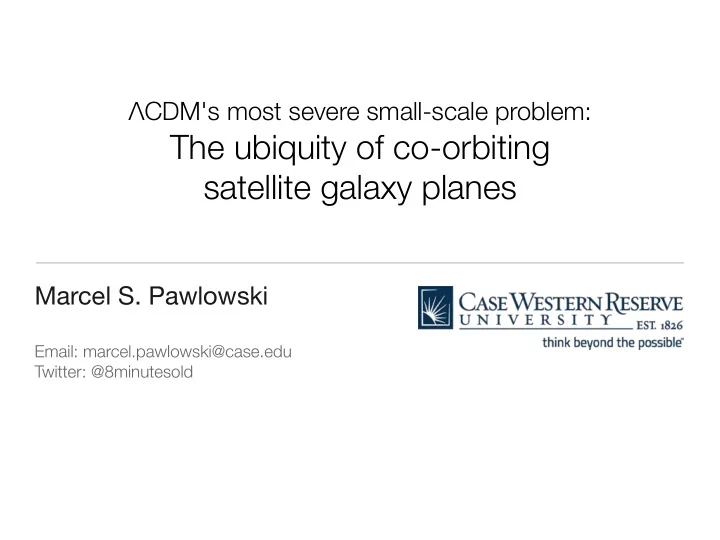

Λ CDM's most severe small-scale problem: The ubiquity of co-orbiting satellite galaxy planes Marcel S. Pawlowski Email: marcel.pawlowski@case.edu Twitter: @8minutesold
Expected distribution of Λ CDM sub-halo satellites Via Lactea project / J. Diemand
The Vast Polar Structure of the Milky Way (VPOS) Pawlowski, Pflamm-Altenburg & Kroupa (2012, MNRAS, 423, 1109) Pawlowski & Kroupa (2013, MNRAS, 435, 2116) VPOS face-on obscured by MW disk obscured by MW disk Proper motions -> 3D velocities ‘Classical’ and faint MW satellites, young halo globular clusters and 50% of streams align in highly flattened (20-30 kpc), co-orbiting structure
Coherent velocities: the VPOS is rotationally stabilized Pawlowski & Kroupa (2013, MNRAS, 435, 2116) • Orbital poles of the MW satellites ➡ directions of angular momenta = normals to orbital planes 8 of 11 satellites co-orbit, 1 counter-orbits in VPOS Likelihood of 0.04% to have this pole concentration from isotropic distribution
The Great Plane of Andromeda (GPoA) Ibata et al. (2013, Nature, 493, 62) edge-on view face-on view <- Milky Way 50% of M31 satellites align in highly flattened (14 kpc) co-orbiting (13 of 15 members) structure. Likelihood of 0.002% if drawn from isotropic distribution
Local Group Satellite Planes as Tests of Λ CDM ... be found in this? Can this ... Via Lactea project / J. Diemand Pawlowski et al. (2012) Ibata et al. (2013) • Important: Planes of co-orbiting sats not predicted by cosmological sims. ➡ Fundamental problem of Λ CDM? • Robust : largely independent of exact baryon physics (>100 kpc scales). • Promising : Origin of satellite planes might provide important information to find (unified) solution for other small-scale problems.
Co-orbiting satellite planes extremely rare in Λ CDM Pawlowski & Kroupa (2013, MNRAS, 435, 2116), Pawlowski+(2014, MNRAS, 442, 2362), Pawlowski & McGaugh (2014, ApJL, 789, 24) Comparing observed satellite population 11 brightest, unobscured satellites with cosmological simulations (ELVIS, Millennium-II, Via Lactea 1 & 2, Aquarius) Concentration of orbital poles Shown example: ELVIS simulations (Local-Group-like host pairs) (Garrison-Kimmel et al 2014, MNRAS, 438, 2578) ➡ 1 of 4800 realizations fulfills thickness and co-orbiting criterion simultaneously (checking 11 brightest MW sats only!) measured for VPOS RMS height of satellite plane [kpc] Chance to find VPOS and GPoA in Λ CDM sims < 0.001%
Beyond the Local Group: Velocity anti-correlation of opposed satellites in SDSS Ibata et al. (2014, Nature, 511, 563) Most pairs have anti-correlated velocities, face-on view suggests 60% of sats co-orbit in planes Likelihood of 0.006% if drawn <- Milky Way from Λ CDM simulation
Claims of consistency of sat. planes with Λ CDM Pawlowski et al. (2012, MNRAS, 424, 80), Pawlowski et al. (2014, MNRAS, 442, 2362) • Published claims of consistency between Λ CDM and observed satellite structures are based on flawed analyses. Problems include: • Consistency claimed in abstract but not tested in paper. • Problem changed to one more easily solved in Λ CDM. • Correlated satellite kinematics have been ignored. • Simulated satellites selected from di ff erent survey volume than observed. • Initial model assumptions already inconsistent with observed situation.
Tidal dwarf galaxies (TDGs) • Second-generation galaxies in debris Open issues: of galaxy collisions. • Should be dark-matter-free • Phase-space correlated ➡ Non-equilibrium dynamics? ➡ Consistent with VPOS & GPoA. (Kroupa 1997; Casas+2012) ➡ Gas stripping? (Yang+2014) (Pawlowski+2011, 2012a,b, Hammer+2013) • Can survive formation phase ➡ MOND? (Benoit’s talk on Thursday) ➡ Observed (Duc+2011) • Mass-Metallicity relation ➡ Simulated (Recchi+2007; Plöckinger+2014) ➡ Ancient TDGs less pre-enriched? Weilbacher et al. (2002) 2-3 Gyr old Tadpole Dentist Chair NGC 5557 Duc et al. (2011)
Conclusions • Co-orbiting satellite planes observed around MW, M31, and in SDSS, are extremely rare in Λ CDM simulations: e.g. Pawlowski+ 2014, Pawlowski & McGaugh 2014b ➡ Fundamental problem, baryons don’t help. • TDGs consistent with sat. planes, but open issues: vel. disp., mass-metallicity. e.g. Pawlowski+ 2011, Pawlowski+ 2012a, Hammer+ 2013, Yang+ 2014 • Whole Local Group is highly structured: Pawlowski+ 2013, Pawlowski & McGaugh 2014a GPoA VPOS
Recommend
More recommend